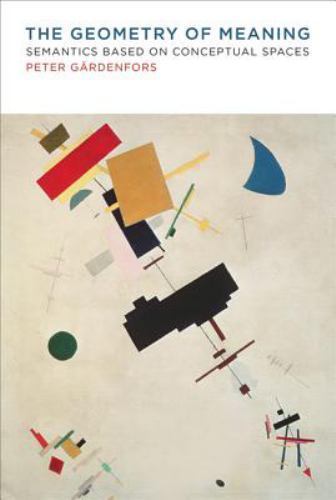Picture 1 of 8

Stock photo








Picture 1 of 8

Stock photo








Geometry of Meaning : Semantics Based on Conceptual Spaces by Peter Gärdenfors (2014, Hardcover)

Friends of the Palo Alto Library (2780)
99.8% positive feedback
Price:
US $129.99
ApproximatelyRM 546.87
+ $22.07 shipping
Returns:
30 days return. Buyer pays for return shipping. If you use an eBay shipping label, it will be deducted from your refund amount.
Condition:
Oops! Looks like we're having trouble connecting to our server.
Refresh your browser window to try again.
About this product
Product Identifiers
PublisherMIT Press
ISBN-100262026783
ISBN-139780262026789
eBay Product ID (ePID)175157121
Product Key Features
Number of Pages356 Pages
LanguageEnglish
Publication NameGeometry of Meaning : Semantics Based on Conceptual Spaces
Publication Year2014
SubjectCognitive Science, Linguistics / Semantics, Cognitive Psychology & Cognition, Linguistics / Psycholinguistics
TypeTextbook
AuthorPeter Gärdenfors
Subject AreaLanguage Arts & Disciplines, Science, Psychology
FormatHardcover
Dimensions
Item Height0.9 in
Item Weight21.4 Oz
Item Length9.2 in
Item Width5.9 in
Additional Product Features
Intended AudienceScholarly & Professional
LCCN2013-022298
TitleLeadingThe
Dewey Edition23
Grade FromCollege Graduate Student
IllustratedYes
Dewey Decimal401/.43
SynopsisA novel cognitive theory of semantics that proposes that the meanings of words can be described in terms of geometric structures. In The Geometry of Meaning , Peter Gärdenfors proposes a theory of semantics that bridges cognitive science and linguistics and shows how theories of cognitive processes, in particular concept formation, can be exploited in a general semantic model. He argues that our minds organize the information involved in communicative acts in a format that can be modeled in geometric or topological terms--in what he terms conceptual spaces , extending the theory he presented in an earlier book by that name. Many semantic theories consider the meanings of words as relatively stable and independent of the communicative context. Gärdenfors focuses instead on how various forms of communication establish a system of meanings that becomes shared between interlocutors. He argues that these "meetings of mind" depend on the underlying geometric structures, and that these structures facilitate language learning. Turning to lexical semantics, Gärdenfors argues that a unified theory of word meaning can be developed by using conceptual spaces. He shows that the meaning of different word classes can be given a cognitive grounding, and offers semantic analyses of nouns, adjectives, verbs, and prepositions. He also presents models of how the meanings of words are composed to form new meanings and of the basic semantic role of sentences. Finally, he considers the future implications of his theory for robot semantics and the Semantic Web., A novel cognitive theory of semantics that proposes that the meanings of words can be described in terms of geometric structures. In The Geometry of Meaning , Peter G rdenfors proposes a theory of semantics that bridges cognitive science and linguistics and shows how theories of cognitive processes, in particular concept formation, can be exploited in a general semantic model. He argues that our minds organize the information involved in communicative acts in a format that can be modeled in geometric or topological terms--in what he terms conceptual spaces , extending the theory he presented in an earlier book by that name. Many semantic theories consider the meanings of words as relatively stable and independent of the communicative context. G rdenfors focuses instead on how various forms of communication establish a system of meanings that becomes shared between interlocutors. He argues that these "meetings of mind" depend on the underlying geometric structures, and that these structures facilitate language learning. Turning to lexical semantics, G rdenfors argues that a unified theory of word meaning can be developed by using conceptual spaces. He shows that the meaning of different word classes can be given a cognitive grounding, and offers semantic analyses of nouns, adjectives, verbs, and prepositions. He also presents models of how the meanings of words are composed to form new meanings and of the basic semantic role of sentences. Finally, he considers the future implications of his theory for robot semantics and the Semantic Web.
LC Classification NumberP325.5.P78G35 2014
Be the first to write a review





